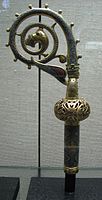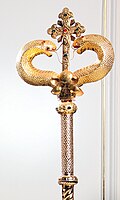
Back صولجان الأسقف Arabic Пастарал Byelorussian Bazh-eskob Breton Bàcul pastoral Catalan Biskupská berla Czech Bispestav Danish Krummstab German Ποιμαντορική ράβδος Greek Episkopa bastono Esperanto Báculo pastoral Spanish
This article needs additional citations for verification. (January 2017) |

A crozier or crosier (also known as a paterissa, pastoral staff, or bishop's staff)[1] is a stylized staff that is a symbol of the governing office of a bishop or abbot and is carried by high-ranking prelates of Roman Catholic, Eastern Catholic, Eastern Orthodox, Oriental Orthodox, Malankara Mar Thoma Syrian Church, and some Anglican, Lutheran, United Methodist and Pentecostal churches.
In Western Christianity the crozier typically takes the form of a shepherd's crook, a tool used to manage flocks of sheep and herds of goats. In Eastern Christianity, the crozier has two common forms: tau-shaped, with curved arms, surmounted by a small cross; or a pair of sculptured serpents or dragons curled back to face each other, with a small cross between them.
Other typical insignia of prelates are the mitre, the pectoral cross, and the episcopal ring.
- ^ Chisholm, Hugh, ed. (1911). . Encyclopædia Britannica. Vol. 7 (11th ed.). Cambridge University Press. p. 520.


